TOPIC: SECOND SERMON
By Len Mier
TOPIC: Transfiguration of Christ as presented in St. Luke’s Gospel (9:28-36)
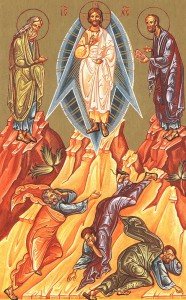
Transfiguration
Every year the Church celebrates this great feast of the transfiguration of Christ, one of the twelve great feasts of the Church. A feast that reveals to us something about our own salvation, we are presented on this day with the transfiguration account as told in St. Luke’s Gospel.
Luke’s gospel account of the transfiguration of Christ is not one we normally hear unless we attend Matins for this great feast. It is the account as given by St. Matthew that we normally hear during liturgy. At Matins Luke’s account is used in place of what is normally a gospel reading that depicts the resurrection of our Lord. I think it is appropriate that this reading is placed in the Matins service. The opening line in Luke’s telling of this miracle states “after eight days” the event takes place. What a powerful proclamation. The idea of the eight day is but one of the strong resurrection images in this gospel that makes it unique among the three transfiguration accounts. While all three of the synoptic gospels recount this event, Luke telling of the event is the most unique among them.
Luke was probably not Jewish, and tradition tells us he was most likely of Greek origin and a follower of the Apostle Paul. Luke’s audience was most likely of Gentile origin, probably the same communities that Paul evangelized. His perspective of what happened on the Mount of Transfiguration was written to reaffirm the faith of those who were not deeply rooted in the Jewish mind set. Saint Luke set forth his reason for writing his gospel as to give an orderly account so you may be certain of the teachings you received.
Luke, after his opening revelation, points us to the fact that Christ took the three apostles with him to pray on the mountain. Unique with Luke, he presents this event and Jesus’ agony in the garden as the only time Jesus’ prayer is shared with his disciples, otherwise prayer was always done in private between Jesus and his Father. Just as in the garden we find the same three overcome with sleep only to be wakened as Jesus enters into His glory.
As I have said, one of the most striking statements of Luke is that eight days have passed. The eight day is seen as the Lord’s Day, a day outside the normal cycle of time and events. We as Eastern Christians refer to the Great Feast of the Resurrection as the eighth day. This in my mind makes me question if Luke was telling his readers of a post-resurrection encounter not a pre-crucifixion event, since there is no admonition to his disciples not to tell anyone till he has risen from the dead. It is as if Jesus is allowing James, John and Peter to a share in his resurrection, but their lack of understanding prevents them sharing what they have seen.
Luke in his account also points to the fact that as Jesus prayed, He encountered God the Father. During this interaction with His Father Jesus’ face changed in appearance becoming dazzling bright. Unlike for us, Jesus in this change is not a change by coming in contact with the Divine but a revelation of the Divine in his person. For us to change, or our salvation, is made by us coming in contact and being made aware of the Divine in us.
It as if Luke is recalling for those not of the Jewish faith the story of the encounter of Moses, also seen in this vision, how upon encountering God in the burning bush became radiant. In that event Moses encounter with the divine changed him. This touching of the divine and mankind changes God’s creation in some physical and spiritual way, it causes salvation.
It is once this visible change in Jesus’ appearance takes place does Luke tell us that conversing with Jesus are two of the greatest teachers in salvation history. Moses the person whose appearance was changed and his vocation established by his contact with the divine goes on to bring the law that will bring God’s people closer to Him. Elijah, one the greatest prophets in the Old Testament also appears in this vision. His message to God’s people transformed Elijah and the people of God to a closer union of God to mankind. It is Elijah who returns to God in a flash of light.
Luke in his narrative also gives his readers and us insight on what the discussion among the three persons in this vision contained. While in this glory Jesus talks of “his exodus” that will take place in Jerusalem. To Luke’s non-Jewish reader whose community or nation was not shaped by the salvific act of bringing God’s people out of physical slavery the Old Testament exodus did not have the same gravity of meaning to those who Luke paints the image for this new community of believers that Jesus’ resurrection and glorification by the Father is the new exodus and community establishing event, delivering of this new community of believers from the slavery of our human nature.
The last thing I have to point out is Luke tells us that God the Father’s presence is also made manifest in this event. In the same imagery found elsewhere in scripture, and in many cultures encounter with the Divine, a cloud comes and shadows the people experiencing a vision of the Divine, a Divine affirmation of the event is given to the partakers.
What do Christians today need to take away from this event presented to us today? We need to wake from our slumber to the realization that if we truly believe that the glory of God dwells with in us, or reflected from us, we must be open to see and show forth that glory in some way. We need to take to heart the voice of the Divine so that we too can share in Jesus’ glory and shine forth and show it in our appearance as the light shone though Moses and Elijah.
***************
I would again encourage my readers to think about this and reflect upon what is being said!
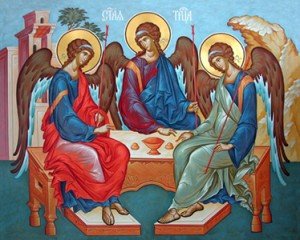 Absolutely critical to our understanding of Eastern spirituality is our acceptance of how the Fathers conceived the nature of humanity. This follows upon the thoughts I shared in the last issue of this article. The Eastern Fathers of the Church clearly set forth the notion that human beings are created in the image and likeness of God. This doctrine is central not only to their understanding of human nature, but also to their theology as a whole. A modern theologian has remarked:
Absolutely critical to our understanding of Eastern spirituality is our acceptance of how the Fathers conceived the nature of humanity. This follows upon the thoughts I shared in the last issue of this article. The Eastern Fathers of the Church clearly set forth the notion that human beings are created in the image and likeness of God. This doctrine is central not only to their understanding of human nature, but also to their theology as a whole. A modern theologian has remarked:
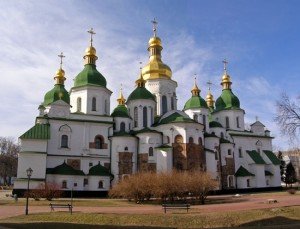
 As I ended this article in the last issue, in the 90’s, but drawing on an earlier tradition related to John, a disciple of John produced a Gospel somewhat different from the three synoptic gospels. On the one hand, in John there were preserved historical reminiscences lost or over-simplified in the earlier Gospels; on the other hand, there was a truly profound theologizing of the words and deeds of Jesus.
As I ended this article in the last issue, in the 90’s, but drawing on an earlier tradition related to John, a disciple of John produced a Gospel somewhat different from the three synoptic gospels. On the one hand, in John there were preserved historical reminiscences lost or over-simplified in the earlier Gospels; on the other hand, there was a truly profound theologizing of the words and deeds of Jesus.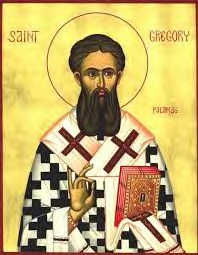 I have been sharing with my readers the thoughts of St. Gregory of Nazianzus on the mystery and wonder of the Trinity. I would continue to share his thoughts with the hope that they stimulate my readers to actually reflect on how they see God, Who we believe is Three-In-One.
I have been sharing with my readers the thoughts of St. Gregory of Nazianzus on the mystery and wonder of the Trinity. I would continue to share his thoughts with the hope that they stimulate my readers to actually reflect on how they see God, Who we believe is Three-In-One.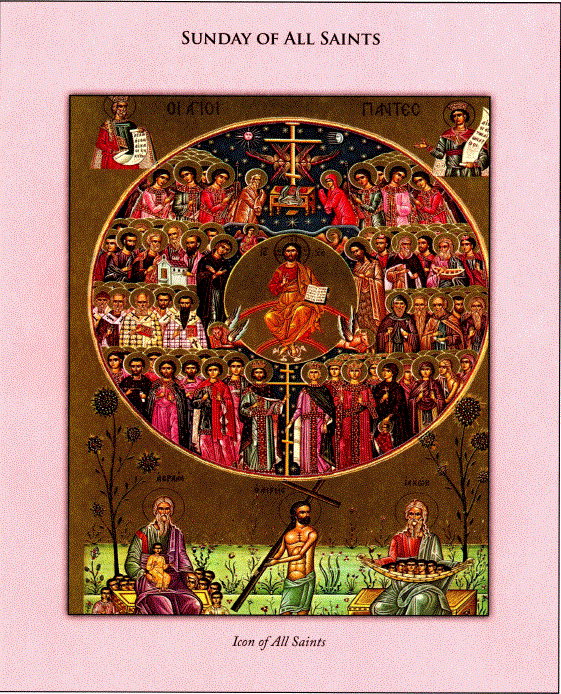 On this weekend of ALL SAINTS, our readings are taken from Paul’s Letter to the Hebrews and Matthew’s Gospel. The opening sentence of the eleventh chapter of Paul’s letter states this: “Faith is confident assurance concerning what we hope for and conviction about things we do not see.” A truly powerful statement on which we do well to reflect. Then in chapter 12 he provides us with this exhortation: “let us keep our eyes fixed on Jesus, who inspires and perfects our faith”.
On this weekend of ALL SAINTS, our readings are taken from Paul’s Letter to the Hebrews and Matthew’s Gospel. The opening sentence of the eleventh chapter of Paul’s letter states this: “Faith is confident assurance concerning what we hope for and conviction about things we do not see.” A truly powerful statement on which we do well to reflect. Then in chapter 12 he provides us with this exhortation: “let us keep our eyes fixed on Jesus, who inspires and perfects our faith”. The eighth weekend after Pascha, that is the first weekend after Pentecost, is call the Weekend of ALL SAINTS. This feast completes the cycle of moveable feasts. On this day the Eastern Church pays particular veneration to all those who are the fruit of the gifts of the Holy Spirit and, I believe, also highlights God’s plan for all Christians. We all have been called to be saints. I know that many will immediately think that this is truly an impossible task. It is not! I requires us, however, to embrace the WAY OF JESUS.
The eighth weekend after Pascha, that is the first weekend after Pentecost, is call the Weekend of ALL SAINTS. This feast completes the cycle of moveable feasts. On this day the Eastern Church pays particular veneration to all those who are the fruit of the gifts of the Holy Spirit and, I believe, also highlights God’s plan for all Christians. We all have been called to be saints. I know that many will immediately think that this is truly an impossible task. It is not! I requires us, however, to embrace the WAY OF JESUS.